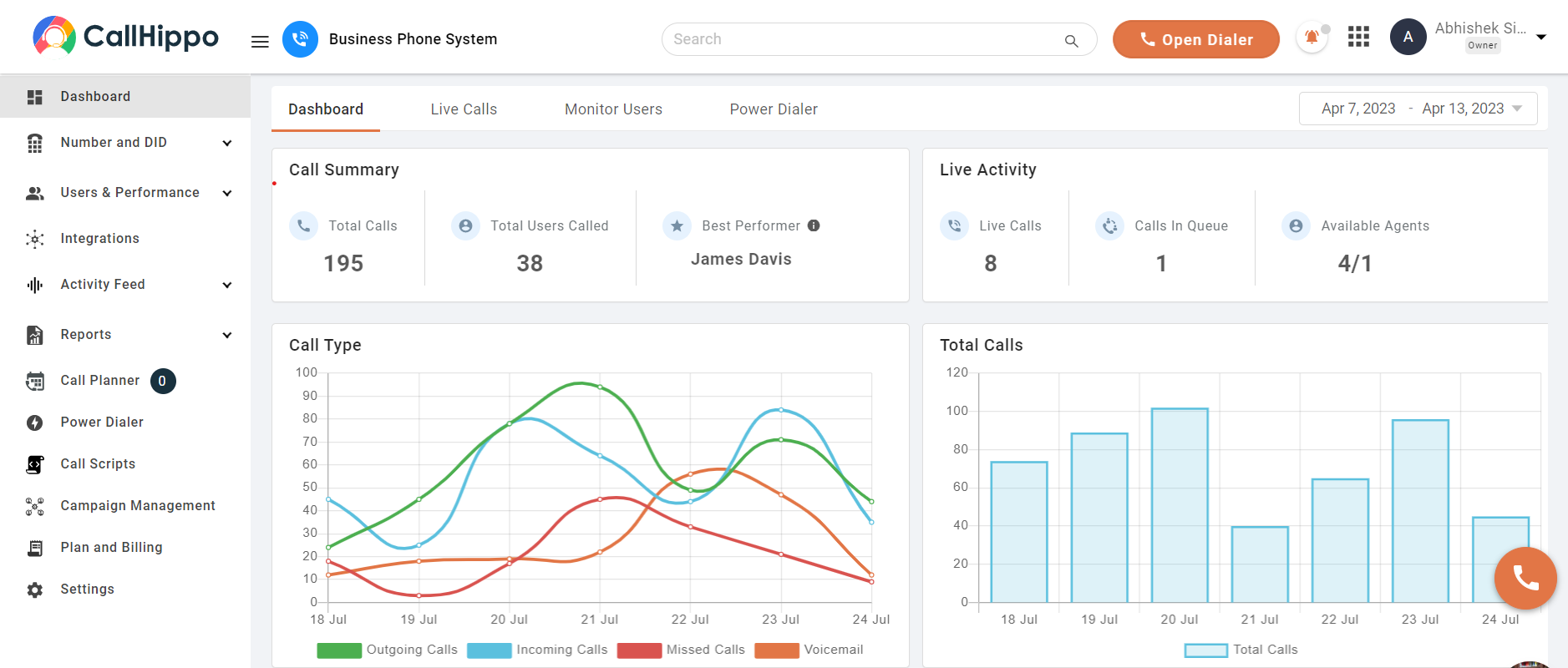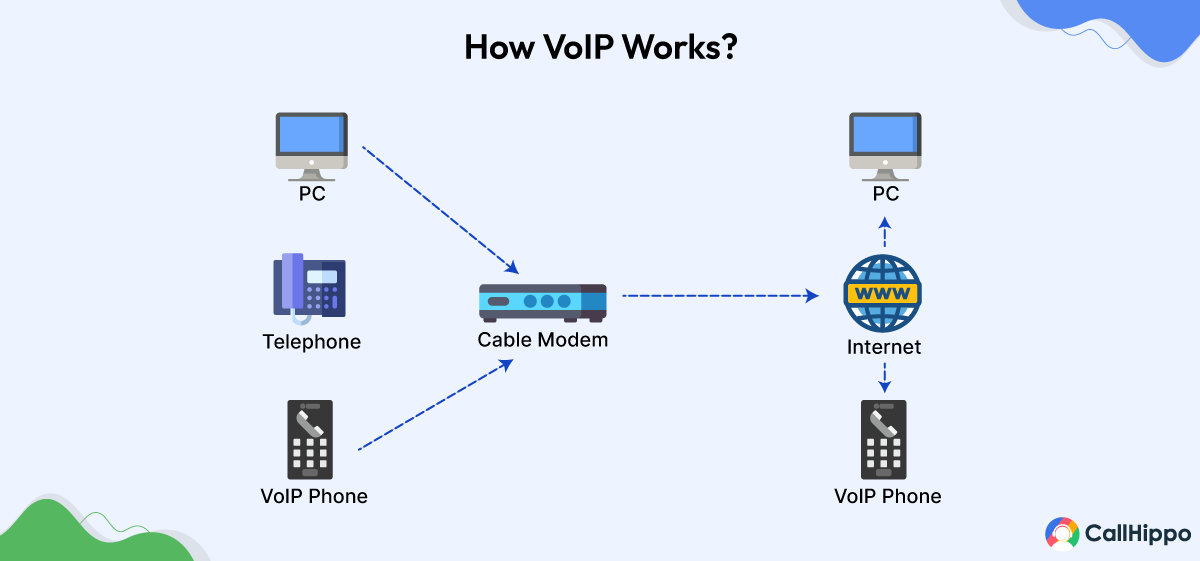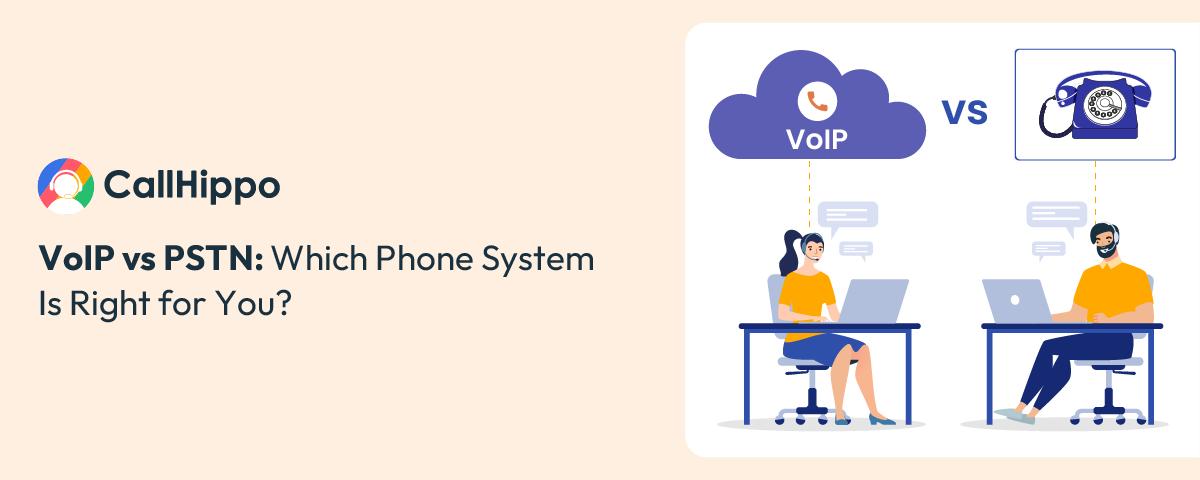For any business to be successful, having an effective communication channel is the backbone. So, to stay ahead, it’s crucial to get your hands on the right communication system that sits well with your business needs.
For years, the Public Switched Telephone Network (PSTN) has been the preferred choice for businesses. However, with the rise of VoIP calls, businesses now seem to have a better alternative. Both systems have their strengths.
But how do you choose the right one for your business? In this blog, we’ll learn the differences between VoIP and PSTN lines and help you make a better choice.
In Hurry? Get the overview in 15 Seconds
- PSTN (Public Switched Telephone Network) and VoIP (Voice over Internet Protocol) are two different communication methods. PSTN uses landline phones and circuit switching to transmit voice calls. VoIP is more about the Internet and packet-switching technology.
- In VoIP you get greater flexibility, lower costs, and advanced features, which makes it a popular choice for businesses.
- On the other hand, PSTN is known for its reliability and wide coverage, and is a reliable option in areas with limited internet access.
What is PSTN?
PSTN full form is Public Switched Telephone Network. It is a phone system that uses telephone lines to connect telephone calls. On this telephone service, your voice data is transmitted in an analog format.
This phone system has been widely used in the United States for many decades.
POTS ( Plain Old Telephone Service) is the traditional version of PSTN. It is the basic analog phone service that many people used before VoIP phone systems became popular. In this era, traditional landline phones were used, allowing users to easily receive calls and make communications through the PSTN phone network.
How does it work?
Let’s see the working of the PSTN line in its three uses:
1. Making a Call
When you call a phone number, your voice turns into an electrical signal that travels through copper wires or fiber optics.
2. Switching Centers:
The voice signal passes through switching centers that direct your call to the right location.
3. Receiving the Call:
On the other side, the voice signal is turned back into sound so the person on the other end can listen to your voice.
It has been a reliable system for many years. But only in recent years have people been using more modern systems like VoIP to make phone calls.
- As of 2023, on average, 88 million fixed telephone subscriptions were active in the U.S., which has declined from about 94 million the previous year..
What is VoIP and How Does It Work?
VoIP or Voice Over Internet Protocol is a modern phone system that uses internet access to transmit voice data as digital data packets. This technology is different from VoIP calls. This is because they do not depend on traditional phone lines. They make use of internet connectivity, and phone calls are made via the Internet Protocol.
With Voice over Internet Protocol, you can use any IP phone or even a mobile device to make phone calls.
A big advantage of VoIP technology is the use of packet switching technology. With this, it gets easier to route calls efficiently over the internet.

How does it work?
For VoIP, you only require an internet connection, with which you can connect from any place. It transforms your voice into digital signals and transmits it via the internet.
1. Making a Call
When you make a phone call, your voice is converted into data packets (small pieces of information)
2. Transmission
These data packets travel over the internet connection to the recipient’s mobile device or phone.
3. Receiving the Call
On the other end, the data packets are turned back into sound. This allows the person you’re calling to hear your voice.
Voice Over Internet Protocol is more cost-effective than traditional phone systems. To route calls, it uses the internet, which makes it accessible through your computer, smartphone, or IP phone.

- To boost service quality and support operations, optimize your communication flow with VoIP features like call recording, call forwarding ,and video conferencing. These features can significantly enhance overall productivity.
VoIP vs PSTN: A Detailed Comparison
VoIP and PSTN have played and still play a role in their respective times. PSTN or Phone Switched Telephone Network is a traditional approach that has been used in previous times. No doubt, it had a big role to play during the period’s technology. However, over the years, communication methods have transitioned into VoIP and similar technologies.
Let’s look at the difference between PSTN and VoIP which would help us understand each one better.
| Basis | VoIP or Voice over Internet Protocol | PSTN or Public Switched Telephone Network |
|---|---|---|
| Cost | Lower cost, especially for long distances. | Higher monthly cost. |
| Flexibility | Can be used on any device with internet access (smartphones, computers) | It is tied to physical landlines and devices. |
| Scalability | Easily scalable. Adding users is simple and cost-effective. | Adding users is expensive and complex to scale with more lines or locations. |
| Call Quality | Depends on the internet speed, so the quality can vary. | Here, the speed is typically stable with consistent voice quality. |
| Features |
|
|
| Installation | Quick and easy setup with no physical infrastructure required. | Requires installation of physical telephone lines. |
| Maintenance | Less maintenance, like software updates and internet connectivity. | More maintenance for hardware and telephone lines. |
| Internet Dependency | Fully reliant on a stable internet connection. | It works independently and does not depend on the internet. |
| Integration | It can integrate with CRM systems, email, chat, etc. | Little to no integration facility with other digital platforms. |
| Reliability | Can face interruptions if the internet fails, but there are backup solutions to counteract this. | It offers greater reliability, particularly in regions with limited internet access. |
| Global Reach | Ideal for global communication with internet access anywhere. | Limited to regions with established telephone networks. |
Cost Comparison: PSTN vs VoIP
We went through the key points of the differences between the two. Let’s now examine the feature of cost comparison in detail and understand which one to choose in today’s scenario.
When evaluating the cost of VoIP and PSTN, it’s important to look beyond just price tags. Each system offers its own value, which depends on the needs of your business.
- These cost comparisons are only general estimates and may vary based on the provider, region, and business requirements. We recommend that you consult with service vendors for customized pricing and feature details.
Let’s compare the costs and value of each system:
1. Lower Setup Costs
In VoIP, you just need a little investment. A phone or app and an internet connection. Whereas, in PSTN, the setups can be slightly more expensive, including hardware and installation.
2. Cheaper International Calls
A VoIP phone system is built for global connectivity. It makes international calls significantly cheaper. PSTN, on the other hand, charges high rates for long-distance calling. This greatly impacts businesses that have global clients or operations.
3. No Hidden Fees
In VoIP, there is generally a predictable cost structure. It is mostly a flat monthly fee. PSTN may charge an additional fee for a service update or maintenance. There may also arise other unexpected costs that can quickly add up.
4. No Need for Physical Infrastructure
As VoIP phone services operate through the internet, there is no need for any physical lines or infrastructure. But, PSTN heavily relies on outdated equipment and physical phone lines. So here the long-term costs increase.
5. Scalable Pricing
As your team grows, a VoIP system can scale easily and affordably. It adds new users or features without incurring huge costs. In PSTN, you need to install an additional line for each new user. That’s why it is less preferable when a business has to expand its operations.
- If your business is in a region where power outages are common or has a weak internet connection, make sure that your VoIP system includes a backup cellular network that guarantees uninterrupted access to emergency services.
Should You Switch from PSTN to VoIP?
By far, we discussed what revolves around the two phone systems. We also discussed how it works and the differences between the two. But choosing a phone system for your business is a subjective aspect.
So, should you make a switch from PSTN to VoIP? Let’s consider.
A VoIP system can reduce telecommunications costs by up to 50% when you consider savings on hardware and international calls. Evidently, making a switch from PSTN to VoIP can be an excellent decision if you want to reduce the costs incurred and increase flexibility.
VoIP phone systems are best suited for businesses that need to grow quickly, especially when they require features like call forwarding, video conferencing, or virtual phone numbers.
However, if your business relies on landline phones or requires consistent PSTN calls, consider hybrid solutions that combine the benefits of both.
Conclusion
To sum up, the VoIP system stands out as a more cost-effective, flexible, and feature-packed option for modern businesses. Moreover, for those who are looking to leverage their internet protocol for voice communications.
In spite of that, if your needs are traditional and you have a good telephone infrastructure, then PSTN remains a reliable option for such businesses.
If you’re looking to save on costs or improve customer service, CallHippo’s VoIP service is a simple and affordable solution for your business.
FAQs
1. Is PBX still used with VoIP or PSTN systems?
Yes, PBX is still used with both VoIP and PSTN. For VoIP calls, it’s known as IP-PBX, providing call management and integration with digital systems. For PSTN, a traditional PBX handles call routing through phone lines.
2. Can VoIP and PSTN systems work together?
Definitely, VoIP and PSTN can work together using a VoIP-PSTN gateway. This allows seamless communication between digital and analog systems while businesses transition from PSTN to VoIP.
3. What are the main differences between PSTN and ISDN?
PSTN is an analog phone system used for basic voice calls. ISDN is a digital network that offers higher-quality voice and faster data transmission. It supports multiple channels for both voice and data.

Subscribe to our newsletter & never miss our latest news and promotions.









